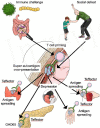A new perspective of frozen shoulder pathology; the interplay between the brain and the immune system
- PMID: 38617059
- PMCID: PMC11009429
- DOI: 10.3389/fphys.2024.1248612
A new perspective of frozen shoulder pathology; the interplay between the brain and the immune system
Abstract
Frozen shoulder (FS), also known as adhesive capsulitis of the shoulder (FS), is a fibrotic inflammatory process of unknown etiology whose main symptoms are pain, stiffness and the loss of joint mobility. These symptoms may be associated with pathologies such as diabetes, Dupuytren's syndrome and the prevalence of today's sedentary lifestyle. This literature review provides an overview of the epidemiology and pathogenesis of this pathology, as well as the mechanisms of lowgrade chronic inflammation and infection, insulin resistance, and omics-science associated with it. We also propose a new hypothesis related to the possibility that the GABAergic system could play a decisive role in the development of frozen shoulder and that therefore diabetes type 1, endocrinological autoimmune disorders and frozen shoulder are connected by the same pathophysiological mechanisms. If that is true, the combined presence of psycho-emotional stress factors and pathogenic immune challenges could be the main causes of frozen shoulder syndrome. Finally, we propose a series of possible intervention strategies based on a multifactorial etiological and mechanistic concept.
Keywords: autoimmune disorder; endocrinological disease; frozen shoulder (adhesive capsulitis); low grade inflammation; psychosocial factors; shoulder condition; shoulder pain.
Copyright © 2024 Navarro-Ledesma, Hamed-Hamed and Pruimboom.
Conflict of interest statement
The authors declare that the research was conducted in the absence of any commercial or financial relationships that could be construed as a potential conflict of interest.
Figures

Similar articles
-
Anti-TNF (adalimumab) injection for the treatment of adults with frozen shoulder during the pain predominant stage protocol for a multi-centre, randomised, double blind, parallel group, feasibility trial.NIHR Open Res. 2023 Apr 24;2:28. doi: 10.3310/nihropenres.13275.2. eCollection 2022. NIHR Open Res. 2023. PMID: 37881307 Free PMC article.
-
Adhesive Capsulitis of the Ankle (Frozen Ankle): An Infrequent Syndrome.Biomedicines. 2023 Sep 5;11(9):2461. doi: 10.3390/biomedicines11092461. Biomedicines. 2023. PMID: 37760901 Free PMC article. Review.
-
Shoulder adhesive capsulitis and shoulder range of motion in type II diabetes mellitus: association with diabetic complications.J Diabetes Complications. 1999 May-Jun;13(3):135-40. doi: 10.1016/s1056-8727(99)00037-9. J Diabetes Complications. 1999. PMID: 10509873
-
Adhesive capsulitis of the shoulder: review of pathophysiology and current clinical treatments.Shoulder Elbow. 2017 Apr;9(2):75-84. doi: 10.1177/1758573216676786. Epub 2016 Nov 7. Shoulder Elbow. 2017. PMID: 28405218 Free PMC article. Review.
-
Proportion and distribution of upper extremity musculoskeletal disorders and its association with disability in type 2 diabetes mellitus.J Hand Ther. 2022 Oct-Dec;35(4):597-604. doi: 10.1016/j.jht.2021.04.013. Epub 2021 Apr 20. J Hand Ther. 2022. PMID: 34016518
Cited by
-
Frozen Shoulder as a Metabolic and Immune Disorder: Potential Roles of Leptin Resistance, JAK-STAT Dysregulation, and Fibrosis.J Clin Med. 2025 Mar 6;14(5):1780. doi: 10.3390/jcm14051780. J Clin Med. 2025. PMID: 40095902 Free PMC article. Review.
-
Comparison of combined suprascapular and axillary nerve pulsed radiofrequency and nerve block for the treatment of primary frozen shoulder: a prospective cohort study.Ann Med. 2025 Dec;57(1):2456692. doi: 10.1080/07853890.2025.2456692. Epub 2025 Feb 4. Ann Med. 2025. PMID: 39903488 Free PMC article.
-
Impact of a Multimodal Intervention Combining Manual Therapy, Exercise, Reduced Methylxanthine Intake, and Nocturnal Light Avoidance on Inflammatory and Metabolic Profiles, Pain, Functionality, and Sleep Quality in Patients with Frozen Shoulder: A Single-Blind Randomized Controlled Trial.J Clin Med. 2025 Jun 26;14(13):4539. doi: 10.3390/jcm14134539. J Clin Med. 2025. PMID: 40648913 Free PMC article.
-
Exploring Pathogenic Genes in Frozen Shoulder through weighted gene co-expression network analysis and Mendelian Randomization.Int J Med Sci. 2024 Oct 21;21(14):2745-2758. doi: 10.7150/ijms.98505. eCollection 2024. Int J Med Sci. 2024. PMID: 39512681 Free PMC article.
-
Impact of needle warming moxibustion combined with trigger point massage on shoulder function and stress responses in elderly patients with frozen shoulder.Am J Transl Res. 2024 Sep 15;16(9):4671-4679. doi: 10.62347/DMTS8090. eCollection 2024. Am J Transl Res. 2024. PMID: 39398553 Free PMC article.
References
Publication types
LinkOut - more resources
Full Text Sources

